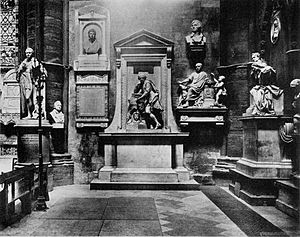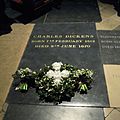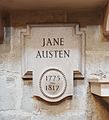Poet's Corner facts for kids

Poets' Corner is a very special part of Westminster Abbey in London. It's located in the south transept, which is like a wing of the church. For hundreds of years, important people have been buried or honored here. Most of them are famous poets, playwrights, and writers. They are recognized for their amazing contributions to British culture.
The first person buried here was Geoffrey Chaucer in 1400. He wrote The Canterbury Tales. When another famous poet, Edmund Spenser, was buried nearby in 1599, it became a tradition. Since then, many literary greats have found their final resting place or a memorial in this corner.
It's not automatic for someone to be honored here after they die. For example, Lord Byron, a famous poet, died in 1824. But his memorial wasn't placed in Poets' Corner until 1969. This shows how carefully people are chosen for this special honor.
Contents
Famous People Buried Here
Many celebrated writers and thinkers are buried in Poets' Corner. Their graves remind us of their lasting impact on the world.
- Geoffrey Chaucer (c. 1343–1400): A very early English poet, famous for The Canterbury Tales.
- Edmund Spenser (c. 1552–1599): A poet known for his epic poem The Faerie Queene.
- Francis Beaumont (1584–1616): A playwright who often worked with John Fletcher.
- Abraham Cowley (1618–1667): A well-known poet of his time.
- John Dryden (1631–1700): A poet and playwright who was England's first Poet Laureate.
- Alexander Pope (1688–1744): A famous poet known for his witty and satirical works.
- George Frideric Handel (1685–1759): A German-born composer who became famous in England.
- Dr Samuel Johnson (1709–1784): A writer who created the first English dictionary.
- David Garrick (1717–1779): A very popular actor and playwright.
- Robert Burns (1759–1796): A Scottish poet, often called the National Poet of Scotland.
- Lord Byron (1788–1824): A leading figure of the Romantic movement in poetry.
- Charles Dickens (1812–1870): A beloved novelist who wrote Oliver Twist and A Christmas Carol. His funeral was kept secret and early in the morning, as he wished for no grand ceremony.
- Robert Browning (1812–1889): A Victorian poet known for his dramatic monologues.
- Alfred Tennyson (1809–1892): Another major Victorian poet and Poet Laureate.
- Thomas Hardy (1840–1928): A famous novelist and poet. His heart was buried in his hometown, but his ashes were placed in the Abbey.
- Rudyard Kipling (1865–1936): An author and poet, famous for The Jungle Book.
- John Masefield (1878–1967): A Poet Laureate whose ashes were placed here.
- T. S. Eliot (1888–1965): A very important poet and playwright of the 20th century.
- Laurence Olivier (1907–1989): One of the greatest actors in British history.
- Ted Hughes (1930–1998): A Poet Laureate, one of the most recent to be honored.
Memorials and Tributes
Many people are honored with memorials in Poets' Corner, even if they are not buried there. These memorials can be statues, busts, or special floor stones.
- William Shakespeare (1564–1616): The most famous playwright in English history has a large monument.
- Ben Jonson (1572–1637): A playwright and poet, a friend of Shakespeare.
- John Milton (1608–1674): A poet famous for his epic poem Paradise Lost.
- William Blake (1757–1827): A unique poet and artist.
- Jane Austen (1775–1817): A beloved novelist who wrote Pride and Prejudice.
- Charlotte Brontë (1816–1855), Emily Brontë (1818–1848), and Anne Brontë (1820–1849): The three famous Brontë sisters, all authors.
- Elizabeth Barrett Browning (1806–1861): A leading poet of the Victorian era.
- Lewis Carroll (1832–1898): The author of Alice's Adventures in Wonderland.
- George Eliot (1819–1880): A female novelist whose real name was Mary Ann Evans.
- Henry James (1843–1916): An American-born author who lived much of his life in England.
- John Keats (1795–1821): A key figure in the Romantic poetry movement.
- Percy Bysshe Shelley (1792–1822): Another important Romantic poet.
- Walter Scott (1771–1832): A Scottish novelist and poet.
- William Wordsworth (1770–1850): A major Romantic poet.
- Dylan Thomas (1914–1953): A Welsh poet and writer.
- C. S. Lewis (1898–1963): The author of The Chronicles of Narnia. His memorial was placed in 2013.
- David Frost (1939–2013): A famous journalist and writer.
- Philip Larkin (1922–1985): A well-known 20th-century poet.
First World War Poets
There is a special memorial in Poets' Corner for 16 poets from the First World War. It's a slate stone slab with their names. It was unveiled on November 11, 1985, which was the 67th anniversary of the end of the war.
The memorial includes a quote from Wilfred Owen, one of the poets:
My subject is War, and the pity of War. The Poetry is in the pity.
Some of the poets honored here include:
- Rupert Brooke (1887–1915): Known for his idealistic war sonnets.
- Wilfred Owen (1893–1918): Famous for his powerful and realistic poems about the horrors of war.
- Siegfried Sassoon (1886–1967): Another poet who wrote vividly about the trenches.
- Edward Thomas (1878–1917): Known for his nature poetry, who died in the war.
Royal Ballet Founders
A stone slab memorial was dedicated in 2009 to honor the four founders of the Royal Ballet. This shows that the Abbey also recognizes contributions to other arts, like dance.
- Ninette de Valois (1898–2001): The founder of the Royal Ballet.
- Frederick Ashton (1904–1988): A famous choreographer.
- Constant Lambert (1905–1951): A composer and conductor.
- Margot Fonteyn (1919–1991): A legendary ballerina.
Other Notable Figures in the Abbey
Some writers and artists are honored elsewhere in Westminster Abbey, not just in Poets' Corner.
- Aphra Behn (1640–1689): An important early female author and playwright.
- John Bunyan (1628–1688): The author of The Pilgrim's Progress.
- Margaret Cavendish (1623–1673): A pioneering female author and poet.
- Noël Coward (1899–1973): A famous playwright and composer.
- Ralph Vaughan Williams (1872–1958): A celebrated English composer.
Images for kids
-
Grave of Charles Dickens in Poets' Corner
-
Wall tablet in Poets' Corner commemorating Jane Austen
See also
 In Spanish: Poets' Corner para niños
In Spanish: Poets' Corner para niños



